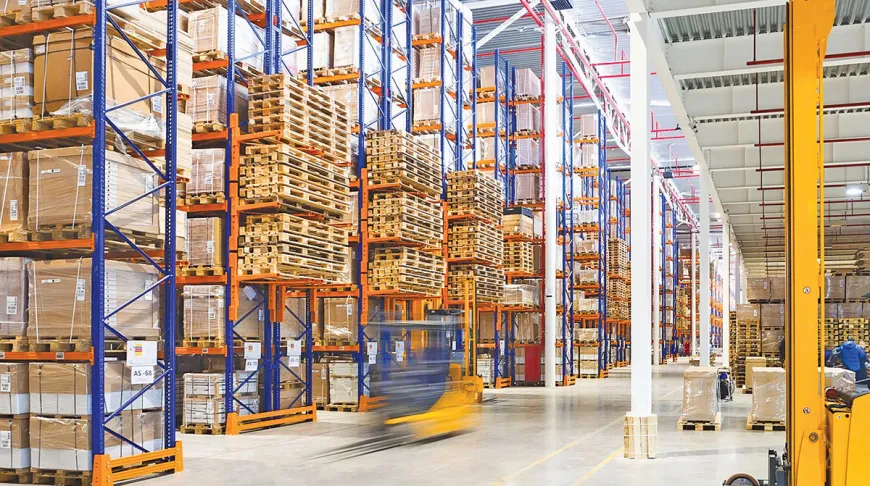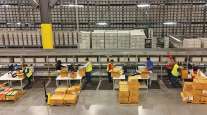Supply chain disruptions can occur at any place and time, creating uncertainty for businesses and consumers alike. The supply chain impacts of the coronavirus pandemic were something of a teachable moment for global businesses. Manufacturers, retailers and even consumers were stung by supply shortages as demand exceeded the available supply of many goods and materials. Even as the economy recovered from the health emergency, people continued to be taken aback by the sight of empty store shelves.
From a supply chain professional’s perspective, the most startling image involved more than 100 cargo vessels idling off the ports of Long Beach and Los Angeles in Southern California. Loaded with as many as 10,500 40’ containers apiece, these were unable to dock and offload their cargo.
In this specific case, officials pointed to COVID-19 as the culprit, but more generally, the problem illustrates the fragility of our supply chains. Going forward, a deeper knowledge of the systemic vulnerabilities and the solutions available will help businesses and government officials avoid future supply chain disruption.

Acute Vs. Recurring Supply Chain Disruptions
Some forms of disruption have a major impact, regionally or globally, but occur very rarely. Others may have less dramatic or widespread impacts but can occur repeatedly. The pandemic is a prime example of the former.
Under the heading of “Acute Supply Chain Disruptions,” we consider:
• Cyberattacks
• Natural disasters
• Geo-political events and influences
Cyberattacks That Threaten Supply Chains
Cyberattacks don’t always make the headlines, but their frequency and potential for harm should not be underestimated.
A recent supply chain survey revealed the following cybersecurity impacts.

Dragos Condrea/Getty Images
• Approximately two-thirds of senior IT professionals polled indicated their organization suffered a software supply chain attack within the last 12 months
• Upwards of 90% suffered a financial loss, averaging $1.1 million
• More than 90% believe their organization remains vulnerable to software supply chain attacks
Weak passwords are one of the main vectors of attack. Other cybersecurity issues affecting supply chain businesses include:
• Human Error: Studies indicate that more than 70% of all data breaches result from human error. Mistakes include clicking on a malicious link contained in an electronic message, visiting a malware-laced platform, or being tricked into disclosing usernames and passwords.
• Upstream Attacks: A supply chain cyberattack need not be a direct assault on a business that moves freight. A common technique is to plant malicious code in software developed by one business and installed by another.
The 2023 Solar Winds hack is an example of an upstream attack. This occurred when cybercriminals inserted malicious code in a software update that was then distributed to customers. Hundreds, if not thousands, of organizations were affected.
A similar supply chain hack affected semiconductor giant Applied Materials. Shipments were disrupted after installing infected software, and Applied Materials suffered a reported $250 million in losses.
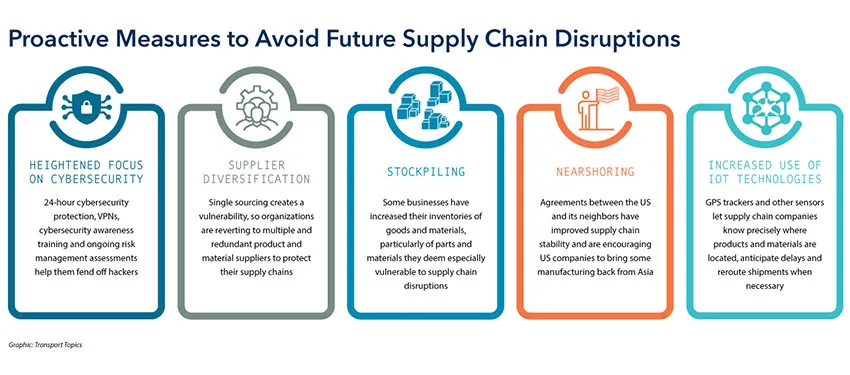
• Internet of Things (IoT) Threats: IoT devices are now widely used by logistics operations to improve supply chain efficiency, but the sensors and GPS technology used to track and locate shipments in real-time have created unexpected vulnerabilities.
While these devices have unlocked greater connectivity and efficiency across many industries, there were a reported 32 million IoT hacks in 2018. By 2022, this had soared to more than 112 million. Persistent problems with IoT technologies in supply chain and other areas include not updating software and subpar cybersecurity defenses.
Although manufacturers are dealing with security gaps, hackers continue to invent new and creative ways to exploit IoT devices.
Regional Disruption: The Colonial Pipeline Hack
Another example of supply chain disruption from a cyberattack is the Colonial Pipeline case, which halted the flow of gasoline and diesel on the U.S. central Eastern Seaboard. Demonstrating the existence of pressure points with the potential to disrupt regional supply chains, this also highlighted the risks of relying on supply chain businesses with a near monopoly.
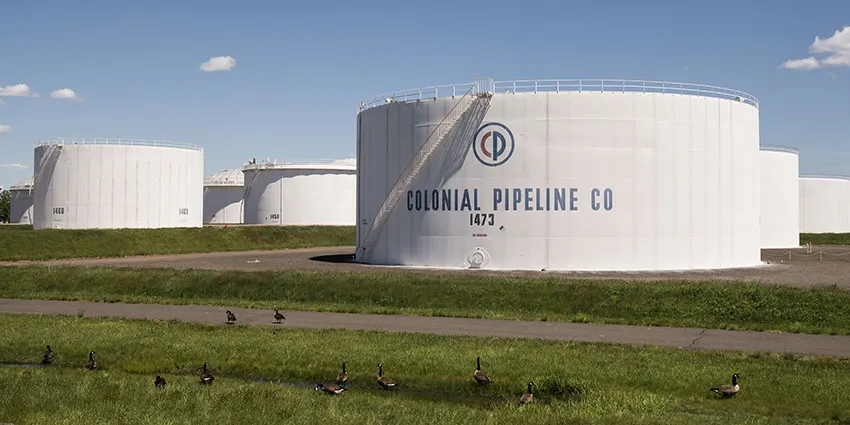
Storage tanks at a Colonial Pipeline facility in Avenel, N.J. (Bloomberg News)
The attack was launched on May 6, 2021, and the organization remained shut down until May 12. In the hardest hit regions service stations closed, forcing businesses and families to park their vehicles.
A shortage of aviation fuel also affected American Airlines, and flight reductions were implemented at airports in Atlanta, Nashville and elsewhere. The White House issued an emergency declaration after Colonial Pipeline officials agreed to pay a $4.4 million ransom in bitcoin.
Although the hack caused prices at the pump to spike, it was the fuel shortage that drove supply chain disruptions. The resulting impacts were so large and widespread that the incident made national headlines.
Natural Disasters Cause Supply Chain Hiccups
Although natural disasters get a great deal of attention from the media, hurricanes and earthquakes typically have a limited impact on supply chains. If a hurricane hits states along the Gulf of Mexico, cargo transportation vehicles are temporarily sidelined, but when the storm subsides and debris is removed, supply chain operations deliver essential goods and materials. The same holds true of blizzards, tornadoes and other severe weather incidents.
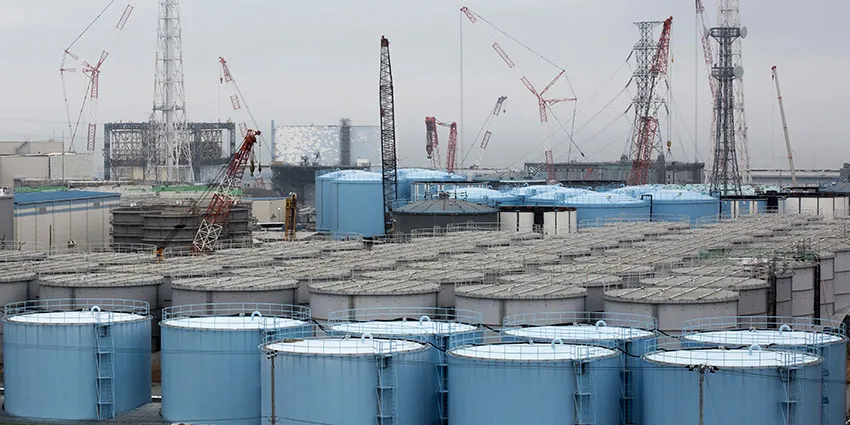
Storage tanks of contaminated water stand at Tokyo Electric Power Co.s Fukushima Dai-ichi nuclear power plant in Okuma, Fukushima, Japan, on Feb. 23,2017. A massive earthquake and tsunami caused a meltdown at the facility nearly six years earlier. (Tomohiro Ohsumi/Bloomberg News)
One exception to short-term supply chain disruption involves earthquakes. Seismic events can weaken bridges and roadways and impact energy supplies. In the case of the 2021 earthquake in Fukushima, Japan, the natural disaster crippled the Fukushima Daiichi nuclear plant and cut power to the region, sending ripples through the global supply chain.
This affected many industries. For example, the world’s leading semiconductor accessory company, Shin-Etsu Handotai, shut down due to the earthquake. So did Toshiba’s flash memory plant and Sony’s lithium battery cell facility, as well as automotive parts producers, and others.
Geopolitical Influences on Supply Chains
Turmoil in the Red Sea has proved to be a threat to supply chain connectivity as evidenced by attacks carried out by the Yemen-back Houthi rebels. Two suspected attacks targeted ships on July 15, according to the Associated Press, as a new U.S. aircraft carrier approached the region to provide security for the key international trade route that has been under assault since the Israel-Hamas war erupted nine months ago.
The aircraft carrier USS Theodore Roosevelt is approaching the Middle East to replace the USS Dwight D. Eisenhower, which spent months in the Red Sea to counter the Houthis.
Government policies, tariffs, free trade agreements, conflicts and economic upheaval all play a role in supply chain operations. Some of these have short-term impacts, others become long-term trends whose effects may only be seen over decades.
To illustrate this point with some examples, recent years have seen a United States-China trade dispute, Brexit, a successor to NAFTA, the pandemic “chip” shortage and the Russia-Ukraine conflict.

Flight deck crew members prepare ordinance for an F/A-18 Super Hornet fighter jet aboard the USS Dwight D. Eisenhower (CVN 69) aircraft carrier during operations in the southern Red Sea, on March 20, 2024. (Christopher Pike/Bloomberg News)
Then there are the longer-term shifts. These are perhaps best exemplified by how, for several decades manufacturing moved from the West to Asia, and especially China, only to be followed by a reshoring and nearshoring trend. As observers have noted, reshoring is now driving growth in factory construction within the U.S.
In 1985, the trade relationship between the U.S. and China was relatively balanced, with China shipping only $6 million more in goods and materials than the U.S. sent back. Almost 40 years later, by 2023, the U.S. trade deficit with China had ballooned to about $380 billion.
This growth in imports from China led to rapid expansion of port facilities and pronounced shifts in domestic supply chain operations such as rail freight and trucking. Instead of rail cars being loaded at U.S. manufacturing plants and supply hubs, they were loaded with containers and raw materials at ocean ports. The same holds true of trucks that typically go wherever freight needs to be picked up and delivered.
The Russia-Ukraine conflict offers an example of rapid supply chain disruption. Historically, Ukraine has exported large quantities of food and other products by ship through the Black Sea. The conflict effectively closed off this route, affecting both the Ukrainian economy and the nations receiving grain and other exports.
To ease the problems caused, the European Union quickly opened alternative overland routes. This let Ukrainian trucks transit EU nations without paying certain regulatory fees, although Polish truckers and farmers instituted international blockades that caused delays.
Recurring Transportation Supply Chain Disruptions
It’s important to understand that the supply chain disruptions caused by the pandemic were not necessarily an anomaly. Even though world economies have returned to relative normalcy, the health emergency exposed the delicate nature of our complex rail freight, ocean shipping, air cargo and truck transportation systems.
Within each sector there are pain points with the potential to cause systemic breakdowns in the flow of goods and materials. Such events have occurred before and may well occur again.
Rail Freight
While working to shorten delivery times and lower costs, particularly in the intermodal space, the railway network is struggling with labor shortages and threatened strikes. In 2022, for example, officials worked feverishly to broker a labor deal that would avoid a strike. According to industry insiders, had this occurred, it would have cost the railroads as much as $1 billion during the first week alone and left consumers facing unevenly stocked shelves and a spike in costs.
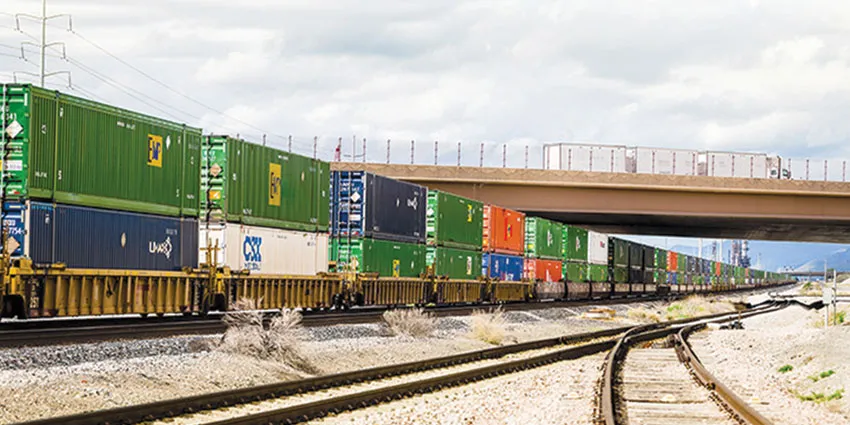
Utah Inland Port Authority
Fortunately for all concerned, this potential supply chain disruption was averted when unions representing railroad workers agreed to a new contract.
Ocean Shipping
Ocean transportation accounts for approximately 80% of all global imports and exports, and war continues to pose a clear and present danger. A recent example is how the Russia-Ukraine conflict interrupted the flow of grain to North Africa. In 2020, more than a dozen African nations imported over 50% of their grain from Ukraine. Shipments all but ceased after the Russian invasion, triggering a grain shortage of approximately 30 million tons.
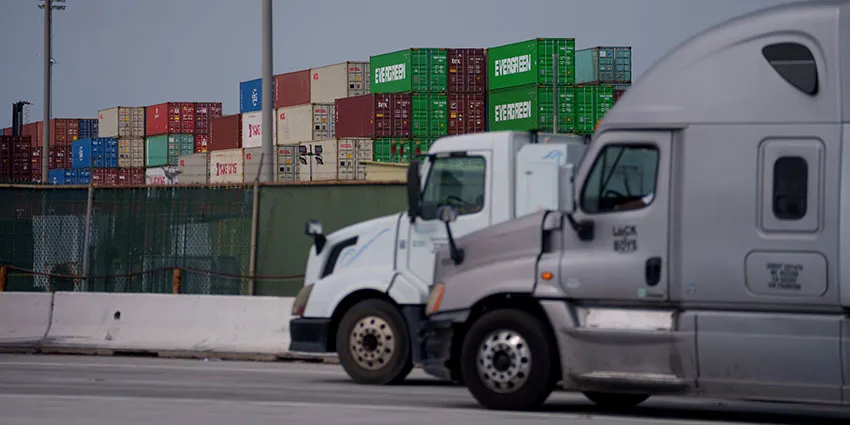
Trucks park at a container terminal at the Port of Los Angeles. (Eric Thayer/Bloomberg News)
Air Transport
The pandemic caused widespread air cargo cancelations, primarily due to labor shortages. Air transportation relies on qualified professionals to fly planes, load and off load cargo and manage flight traffic control. Reductions in airfreight created supply chain disruptions that rippled through the U.S. economy.
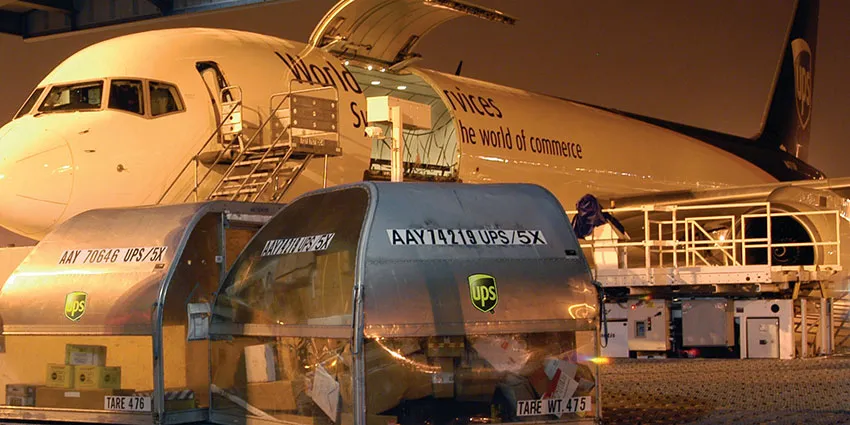
Cargo is handled at UPS' Worldport hub in Louisville, Ky. (UPS Inc.)
Truck Transportation
According to American Trucking Associations, more than 72% of the country’s goods and materials are delivered by truck.
The truck transportation industry has faced higher costs for diesel fuel and other inflationary pressures in recent years while operating in a freight market that has experienced significant peaks and valleys since the pandemic. Nonetheless, motor carriers have continued to deliver loads as business conditions have shifted.
Meanwhile, the expansion of intermodal freight transportation options could help address potential supply chain disruptions that could disrupt single-modality delivery systems. The $1.2 trillion federal infrastructure spending package includes upgrades for ports, rail, highways and air transport.
Economic Impact of Supply Chain Disruptions
Disruptions to supply chains have economic consequences. These may be short term, appearing as shortages of certain products, commodities or components, which can lead to price increases, or long term, as when economies undergo structural shifts, like those toward or away from manufacturing.
Illustrating this last point, it’s well documented that U.S. manufacturing declined as imports from lower cost countries rose. According to the Bureau of Labor Statistics, the number of Americans employed in manufacturing dropped from a high-water mark of 19.6 million in 1979 to 12.8 million in 2019. Over 40 years, the economy lost 7 million manufacturing jobs, even as the population increased.
An example of supply chain disruptions creating shortages was seen during the recent pandemic. Semiconductor “chips” used in products from laptops to automobiles suddenly became hard to obtain due to the ripple effects of the COVID-19 pandemic.
The result was to leave automotive manufacturers starved of these essential components and unable to assemble cars and trucks. With few new vehicles available at dealerships, the price of used vehicles rose dramatically.
As this illustrates, shortages drive up the cost of consumer goods, something to be expected from the relationship between supply and demand.
Price increases can also result from higher costs passing through the supply chain. For instance, the recent rise in grocery prices has been driven in part by increased diesel costs. Diesel powers the semi-trucks used throughout the grocery supply chain — from delivering seeds, feed and fertilizers to transporting produce to processing plants, warehouses and, ultimately, grocery stores. These incremental cost increases accumulate, leading companies to offset them by raising prices at checkout.
Supply chain disruptions can negatively impact business-to-customer relations in two other ways:
• Brand Loyalty: Consumers generally stick with preferred brands until something occurs to disturb that relationship. When supply chain disruptions create shortages, people buy similar products elsewhere. If they grow accustomed to another brand, their loyalty wanes.
• Brand Reputation: E-commerce giants such as Amazon.com maintain market share based on product availability and quick doorstep delivery times. During the pandemic, Amazon and others acted quickly, moving exclusive products to protect their organizations and reputations. Other operations that couldn’t keep supply chains open suffered losses.
In free markets, supply chain disruptions have economic consequences. Businesses need to determine if these are long term and structural or of a short-term nature that will work their way out of the system over time. Having made their evaluation, the actions they take will determine their future success.
Proactive Measures to Avoid Future Supply Chain Disruptions
The disruptions cited previously have reminded corporate decision makers how fragile supply chains can be. Many are being proactive about taking steps to protect their businesses in the future. Here are five measures they can adopt:
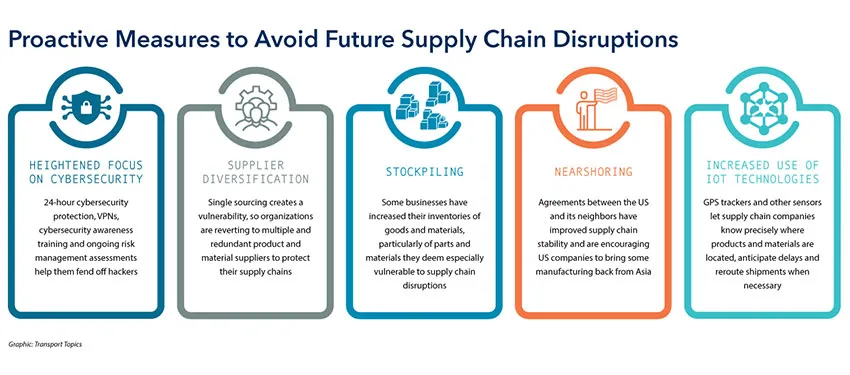
• Heightened focus on cybersecurity: Freight transportation organizations continue to outsource cybersecurity to ensure 24-hour protection. Virtual Security Operations Centers, VPNs, cybersecurity awareness training and ongoing risk management assessments all help with fending off hackers.
• Supplier diversification: Single sourcing, with its goal of driving down prices, creates a vulnerability. Organizations are reverting to multiple and redundant product and material suppliers to protect their supply chains.
• Stockpiling: Some businesses have increased their inventories of goods and materials, particularly of parts and materials they deem especially vulnerable to supply chain disruptions.
• Nearshoring: The United States-Mexico-Canada Agreement (USMCA), an updated version of the North American Free Trade Agreement (NAFTA), has, according to experts, increased supply chain resilience. Together with lessons learned from recent disruptions, this is encouraging U.S. companies to bring some manufacturing back from Asia.
• Increased use of IoT Technologies: GPS trackers and other sensors let supply chain companies know precisely where products and materials are located, anticipate delays and reroute shipments when necessary.
Awareness and Planning Are Key
Global supply chains are highly complex and have multiple vulnerabilities. Attacks and disruptions, whether natural or of human origin, can have expensive and long-lasting consequences.
Three areas to monitor, plan for, and act upon are:
• The risk of cyberattacks
• Natural disasters
• Geopolitical events
It’s not possible to anticipate and plan for every event, but businesses can adopt a proactive stance towards risk identification and reduction. Doing so will strengthen their ability to survive through, and even prosper from, the next supply chain disruption.


